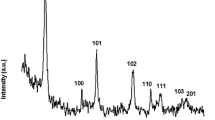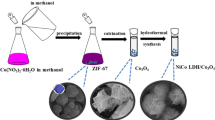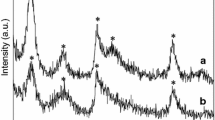Abstract
Pseudocapacitors with high power density, long-term durability, as well as reliable safety, play a key role in energy conversion and storage. Designing electrode materials combing the features of high specific capacitance, excellent rate performance, and outstanding mechanical stability is still a challenge. Herein, a facile partial sulfurization strategy has been developed to modulate the electronic structure and crystalline texture of cobalt hydroxide nanosheets (denoted as Co(OH)2) at room temperature. The resultant cobalt hydroxysulfide nanosheet (denoted as CoSOH) electrode with abundant low-valence cobalt species and amorphous structure, exhibits a high specific capacitance of 2110 F g−1 at 1 A g−1 with an excellent capability retention rate of 92.1% at 10 A g−1, which is much larger than that of Co(OH)2 precursor (916 F g−1 at 1 A g−1 and 80% retention at 10 A g−1). Furthermore, the fabricated asymmetric supercapacitor device con structed with CoSOH and active carbon displays a considerable high energy density of 44.9 W h kg−1 at a power density of 400 W kg−1, and exceptional stability after 8000 cycles.

摘要
赝电容超级电容器具有高功率密度、超长寿命以及可靠的 安全性, 使其在能源转化和存储中扮演着重要角色. 但是, 设计具有 高容量、优异倍率性能以及出色的机械稳定性的电极材料依旧是 一个挑战. 本工作中, 我们采用室温部分硫化策略来调节氢氧化钴 纳米片的电子结构和晶态. 得到的羟基硫化钴具有无定形结构, 同 时还有丰富的低价钴离子. 三电极体系下, 该电极在电流密度为 1 A g−1时的比电容达2110 F g−1, 当电流密度增大至10 A g−1时容量 仍有92.1%的保留, 容量和倍率性能都远高于氢氧化钴前驱体 (916 F g−1 @1 A g−1, 10 A g−1的比电容保留率为80%). 此外, 利用该 电极与商业活性炭组成的不对称电容器具有44.9 W h kg−1的高能 量密度以及优异的稳定性(8000次循环后仅衰减4%).
Similar content being viewed by others
References
Huang Y, Zeng Y, Yu M, et al. Recent smart methods for achieving high-energy asymmetric supercapacitors. Small Methods, 2018, 2: 1700230
Lin Z, Goikolea E, Balducci A, et al. Materials for supercapacitors: When Li-ion battery power is not enough. Mater Today, 2018, 21: 419–436
Salanne M, Rotenberg B, Naoi K, et al. Efficient storage mechanisms for building better supercapacitors. Nat Energy, 2016, 1: 16070
Simon P, Gogotsi Y. Materials for electrochemical capacitors. Nat Mater, 2008, 7: 845–854
Vijayakumar M, Bharathi Sankar A, Sri Rohita D, et al. Conversion of biomass waste into high performance supercapacitor electrodes for real-time supercapacitor applications. ACS Sustain Chem Eng, 2019, 7: 17175–17185
Wu Y, Cao C. The way to improve the energy density of super-capacitors: Progress and perspective. Sci China Mater, 2018, 61: 1517–1526
Xie JQ, Ji YQ, Kang JH, et al. In situ growth of Cu(OH)2@FeOOH nanotube arrays on catalytically deposited Cu current collector patterns for high-performance flexible in-plane micro-sized energy storage devices. Energy Environ Sci, 2019, 12: 194–205
Xiang K, Xu Z, Qu T, et al. Two dimensional oxygen-vacancy-rich Co3O4 nanosheets with excellent supercapacitor performances. Chem Commun, 2017, 53: 12410–12413
Kumar KS, Choudhary N, Jung Y, et al. Recent advances in two-dimensional nanomaterials for supercapacitor electrode applications. ACS Energy Lett, 2018, 3: 482–495
Xie M, Xu Z, Duan S, et al. Facile growth of homogeneous Ni(OH)2 coating on carbon nanosheets for high-performance asymmetric supercapacitor applications. Nano Res, 2018, 11: 216–224
Zhang N, Li Y, Xu J, et al. High-performance flexible solid-state asymmetric supercapacitors based on bimetallic transition metal phosphide nanocrystals. ACS Nano, 2019, 13: 10612–10621
Bonaccorso F, Colombo L, Yu G, et al. Graphene, related two-dimensional crystals, and hybrid systems for energy conversion and storage. Science, 2015, 347: 1246501–41
Balogun MS, Huang Y, Qiu W, et al. Updates on the development of nanostructured transition metal nitrides for electrochemical energy storage and water splitting. Mater Today, 2017, 20: 425–451
Chen Y, Zhou T, Li L, et al. Interfacial engineering of nickel boride/metaborate and its effect on high energy density asymmetric supercapacitors. ACS Nano, 2019, 13: 9376–9385
Yanilmaz M, Dirican M, Asiri AM, et al. Flexible polyaniline-carbon nanofiber supercapacitor electrodes. J Energy Storage, 2019, 24: 100766
Zhang Y, Qu T, Xiang K, et al. In situ formation/carbonization of quinone-amine polymers towards hierarchical porous carbon foam with high faradaic activity for energy storage. J Mater Chem A, 2018, 6: 2353–2359
Gao S, Sun Y, Lei F, et al. Ultrahigh energy density realized by a single-layer β-Co(OH)2 all-solid-state asymmetric supercapacitor. Angew Chem Int Ed, 2014, 53: 12789–12793
Lau GC, Sather NA, Sai H, et al. Oriented multiwalled organic-Co(OH)2 nanotubes for energy storage. Adv Funct Mater, 2018, 28: 1870019
Deng T, Zhang W, Arcelus O, et al. Atomic-level energy storage mechanism of cobalt hydroxide electrode for pseudocapacitors. Nat Commun, 2017, 8: 15194
Gao H, Xin S, Goodenough JB. The origin of superior performance of Co(OH)2 in hybrid supercapacitors. Chem, 2017, 3: 26–28
Wang B, Tang C, Wang HF, et al. A nanosized CoNi hydroxide@hydroxysulfide core-shell heterostructure for enhanced oxygen evolution. Adv Mater, 2019, 31: 1805658
Wang B, Tang C, Wang HF, et al. Core-branch CoNi hydroxysulfides with versatilely regulated electronic and surface structures for superior oxygen evolution electrocatalysis. J Energy Chem, 2019, 38: 8–14
Xiang K, Wu D, Deng X, et al. Boosting H2 generation coupled with selective oxidation of methanol into value-added chemical over cobalt hydroxide@hydroxysulfide nanosheets electrocatalysts. Adv Funct Mater, 2020, 30: 1909610
Zhao H, Chen X, Wang G, et al. Two-dimensional amorphous nanomaterials: synthesis and applications. 2D Mater, 2019, 6: 032002
Li Q, Xu Y, Zheng S, et al. Recent progress in some amorphous materials for supercapacitors. Small, 2018, 14: 1800426
Wang HF, Tang C, Wang B, et al. Bifunctional transition metal hydroxysulfides: room-temperature sulfurization and their applications in Zn-air batteries. Adv Mater, 2017, 29: 1702327
Huang C, Song X, Qin Y, et al. Cation exchange reaction derived amorphous bimetal hydroxides as advanced battery materials for hybrid supercapacitors. J Mater Chem A, 2018, 6: 21047–21055
Xiang K, Guo J, Xu J, et al. Surface sulfurization of NiCo-layered double hydroxide nanosheets enable superior and durable oxygen evolution electrocatalysis. ACS Appl Energy Mater, 2018, 1: 4040–4049
Zeng Y, Chen L, Chen R, et al. One-step, room temperature generation of porous and amorphous cobalt hydroxysulfides from layered double hydroxides for superior oxygen evolution reactions. J Mater Chem A, 2018, 6: 24311–24316
Lv C, Yan C, Chen G, et al. An amorphous noble-metal-free electrocatalyst that enables nitrogen fixation under ambient conditions. Angew Chem Int Ed, 2018, 57: 6073–6076
Perdew JP, Burke K, Wang Y. Generalized gradient approximation for the exchange-correlation hole of a many-electron system. Phys Rev B, 1996, 54: 16533–16539
Lippert G, Hutter JR, Parrinello M. A hybrid Gaussian and plane wave density functional scheme. Mol Phys, 1997, 92: 477–487
VandeVondele J, Krack M, Mohamed F, et al. Quickstep: fast and accurate density functional calculations using a mixed Gaussian and plane waves approach. Comput Phys Commun, 2005, 167: 103–128
VandeVondele J, Hutter J. Gaussian basis sets for accurate calculations on molecular systems in gas and condensed phases. J Chem Phys, 2007, 127: 114105
Goedecker S, Teter M, Hutter J. Separable dual-space Gaussian pseudopotentials. Phys Rev B, 1996, 54: 1703–1710
Grimme S, Antony J, Ehrlich S, et al. A consistent and accurate ab initio parametrization of density functional dispersion correction (DFT-D) for the 94 elements H-Pu. J Chem Phys, 2010, 132: 154104
Selcuk S, Selloni A. DFT+U study of the surface structure and stability of Co3O4 (110): Dependence on U. J Phys Chem C, 2015, 119: 9973–9979
Jana M, Sivakumar P, Kota M, et al. Phase- and interlayer spacing-controlled cobalt hydroxides for high performance asymmetric supercapacitor applications. J Power Sources, 2019, 422: 9–17
Zhao Q, Liu G, Zhang H, et al. Strong SERS performances of ultrathin a-Co(OH)2 nanosheets to the toxic organophosphorus molecules and hydrogen bond-induced charge transfer mechanism. Adv Mater Interfaces, 2018, 5: 1700709
Qin W, Liu Y, Liu X, et al. Facile and scalable production of amorphous nickel borate for high performance hybrid super-capacitors. J Mater Chem A, 2018, 6: 19689–19695
Wang Z, Ji S, Liu F, et al. Highly efficient and stable catalyst based on Co(OH)2@Ni electroplated on Cu-metallized cotton textile for water splitting. ACS Appl Mater Interfaces, 2019, 11: 29791–29798
Liu S, Deng T, Hu X, et al. Increasing surface active Co2+ sites of MOF-derived Co3O4 for enhanced supercapacitive performance via NaBH4 reduction. Electrochim Acta, 2018, 289: 319–323
Ulaganathan M, Maharjan MM, Yan Q, et al. β-Co(OH)2 nanosheets: A superior pseudocapacitive electrode for high-energy supercapacitors. Chem Asian J, 2017, 12: 2127–2133
Mukhiya T, Dahal B, Ojha GP, et al. Engineering nanohaired 3D cobalt hydroxide wheels in electrospun carbon nanofibers for high-performance supercapacitors. Chem Eng J, 2019, 361: 1225–1234
Dai P, Yan T, Hu L, et al. Phase engineering of cobalt hydroxides using magnetic fields for enhanced supercapacitor performance. J Mater Chem A, 2017, 5: 19203–19209
Ding K, Zhang X, Li J, et al. Phase and morphology evolution of ultrathin Co(OH)2 nanosheets towards supercapacitor application. CrystEngComm, 2017, 19: 5780–5786
Yang J, Zhang X, Xu Z, et al. Synthesis of mesoporous Co(OH)2 nanocubes derived from Prussian blue analogue and their electrocapacitive properties. J Electroanal Chem, 2017, 788: 54–60
Chen Y, Pang WK, Bai H, et al. Enhanced structural stability of nickel-cobalt hydroxide via intrinsic pillar effect of metaborate for high-power and long-life supercapacitor electrodes. Nano Lett, 2017, 17: 429–436
Yan S, Abhilash KP, Tang L, et al. Research advances of amorphous metal oxides in electrochemical energy storage and conversion. Small, 2018, 14: 1804371
Peng L, Wang J, Nie Y, et al. Dual-ligand synergistic modulation: A satisfactory strategy for simultaneously improving the activity and stability of oxygen evolution electrocatalysts. ACS Catal, 2017, 7: 8184–8191
Chen M, Qu G, Yang W, et al. Celgard membrane-mediated ion diffusion for synthesizing hierarchical Co(OH)2 nanostructures for electrochemical applications. Chem Eng J, 2018, 350: 209–216
Wang C, Qu H, Peng T, et al. Large scale a-Co(OH)2 needle arrays grown on carbon nanotube foams as free standing electrodes for supercapacitors. Electrochim Acta, 2016, 191: 133–141
Li X, Wu H, Elshahawy AM, et al. Cactus-like NiCoP/NiCo-OH 3D architecture with tunable composition for high-performance electrochemical capacitors. Adv Funct Mater, 2018, 28: 1800036
Liu T, Zhang L, You W, et al. Core-shell nitrogen-doped carbon hollow spheres/Co3O4 nanosheets as advanced electrode for highperformance supercapacitor. Small, 2018, 14: 1702407
Han X, Tao K, Wang D, et al. Design of a porous cobalt sulfide nanosheet array on Ni foam from zeolitic imidazolate frameworks as an advanced electrode for supercapacitors. Nanoscale, 2018, 10: 2735–2741
Yu F, Chang Z, Yuan X, et al. Ultrathin NiCo2S4@graphene with a core-shell structure as a high performance positive electrode for hybrid supercapacitors. J Mater Chem A, 2018, 6: 5856–5861
Deng T, Lu Y, Zhang W, et al. Inverted design for high-performance supercapacitor via Co(OH)2-derived highly oriented MOF electrodes. Adv Energy Mater, 2018, 8: 1702294
Chen T, Li S, Wen J, et al. Rational construction of hollow core-branch CoSe2 nanoarrays for high-performance asymmetric supercapacitor and efficient oxygen evolution. Small, 2018, 14: 1700979
Acknowledgements
This work was surpported by the National Natural Science Foundation of China (21902108, 21975163 and 51902204) and China Postdoctoral Science Foundation (2019M663035). The authors thank the Instrumental Analysis Center of Shenzhen University (Xili Campus) for the help in TEM characterization and analysis. The authors gratefully acknowledge Shiyanjia lab (www.shiyanjia.com) for the XPS test.
Author information
Authors and Affiliations
Contributions
Xiang K conceived the idea. Xiang K and Wang X contributed to the experiments and data analyses. Peng Z conducted the DFT calculations. The paper was primarily written by Xiang K, You W and Peng Z. The project was supervised by Luo JL and Fu XZ. All authors contributed to the general discussion.
Corresponding author
Additional information
Conflict of interest
The authors declare no conflict of interest.
Supplementary information
Supporting data are available in the online version of the paper.
Kun Xiang received his PhD degree in physical chemistry from Nanjing University in 2018. Then he jointed Shenzhen University as a postdoctoral fellow in 2018. His current research focuses on the design and synthesis of 2D nanomaterials for energy storage and conversion.
Xian-Zhu Fu obtained his PhD degree in 2007 from Xiamen University. He carried out postdoctoral research at the University of Alberta. Now he is a professor in the School of Materials Science and Engineering, Shenzhen University. His research interests are the electrochemistry/electrocatalysts for energy materials and devices, electronic materials and process.
Supplementary Information
40843_2020_1362_MOESM1_ESM.pdf
Amorphous cobalt hydroxysulfide nanosheets with regulated electronic structure for high-performance electrochemical energy storage
Rights and permissions
About this article
Cite this article
Xiang, K., Wang, X., You, W. et al. Amorphous cobalt hydroxysulfide nanosheets with regulated electronic structure for high-performance electrochemical energy storage. Sci. China Mater. 63, 2303–2313 (2020). https://doi.org/10.1007/s40843-020-1362-1
Received:
Accepted:
Published:
Issue Date:
DOI: https://doi.org/10.1007/s40843-020-1362-1




